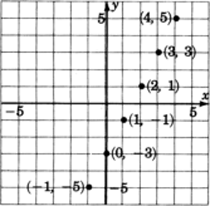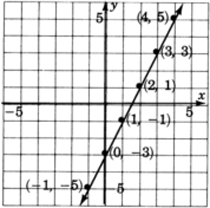This module is from Elementary Algebra by Denny Burzynski and Wade Ellis, Jr.
In this chapter the student is shown how graphs provide information that is not always evident from the equation alone. The chapter begins by establishing the relationship between the variables in an equation, the number of coordinate axes necessary to construct its graph, and the spatial dimension of both the coordinate system and the graph. Interpretation of graphs is also emphasized throughout the chapter, beginning with the plotting of points. The slope formula is fully developed, progressing from verbal phrases to mathematical expressions. The expressions are then formed into an equation by explicitly stating that a ratio is a comparison of two quantities of the same type (e.g., distance, weight, or money). This approach benefits students who take future courses that use graphs to display information.The student is shown how to graph lines using the intercept method, the table method, and the slope-intercept method, as well as how to distinguish, by inspection, oblique and horizontal/vertical lines.
Objectives of this module: be able to relate solutions to a linear equation to lines, know the general form of a linear equation, be able to construct the graph of a line using the intercept method, be able to distinguish, by their equations, slanted, horizontal, and vertical lines.
Overview
- Solutions and Lines
- General form of a Linear Equation
- The Intercept Method of Graphing
- Graphing Using any Two or More Points
- Slanted, Horizontal, and Vertical Lines
Solutions and lines
We know that solutions to linear equations in two variables can be expressed as ordered pairs. Hence, the solutions can be represented by point in the plane. We also know that the phrase “graph the equation” means to locate the solution to the given equation in the plane. Consider the equation
. We’ll graph six solutions (ordered pairs) to this equation on the coordinates system below. We’ll find the solutions by choosing
(from
), substituting them into the equation
, and then solving to obtain the corresponding
. We can keep track of the ordered pairs by using a table.
|
If
|
Then
|
Ordered Pairs |
|
|
|
|
| 0 |
|
|
| 1 |
|
|
| 2 |
1 |
|
| 3 |
3 |
|
| 4 |
5 |
|

We have plotted only six solutions to the equation
. There are, as we know, infinitely many solutions. By observing the six points we have plotted, we can speculate as to the location of all the other points. The six points we plotted seem to lie on a straight line. This would lead us to believe that all the other points (solutions) also lie on that same line. Indeed, this is true. In fact, this is precisely why first-degree equations are called
linear equations.
Linear equations produce straight lines

There is a standard form in which linear equations in two variables are written. Suppose that
,
, and
are any real numbers and that
and
cannot both be zero at the same time. Then, the linear equation in two variables


